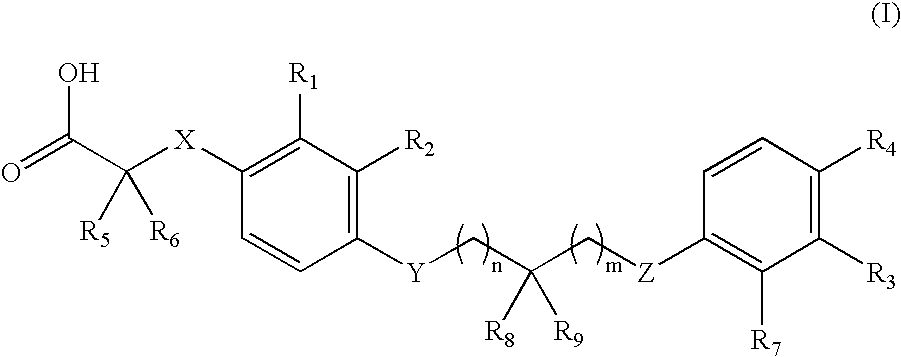4-((phenoxyalkyl)thio)-phenoxyacetic acids and analogs
a technology of phenoxyacetic acid and thiosethyl phenoxyacetic acid, which is applied in the direction of drug compositions, peptide/protein ingredients, metabolic disorders, etc., can solve the problems of insufficient insulin activation of glucose uptake, oxidation and storage in muscle, inadequate insulin repression of lipolysis in adipose tissue, and insufficient glucose production and secretion in liver, etc. undesirable effects have occurred in animal and/or
- Summary
- Abstract
- Description
- Claims
- Application Information
AI Technical Summary
Benefits of technology
Problems solved by technology
Method used
Image
Examples
example i
[0157]
{2-Methyl-4-[2-(4-trifluoromethyl-phenoxymethyl)-allylsulfanyl]-phenoxy}-acetic Acid
[0158]
(4-Chlorosulfonyl-2-methyl-phenoxy)-acetic Acid Ethyl Ester
[0159]To a flask containing chlorosulfonic acid (15.0 mL, 226 mmol) at 4° C. was added ethyl (2-methylphenoxy)acetate 1-A (10.0 g, 51.6 mmol) slowly. The mixture was stirred at 4° C. for 30 min and room temperature for 2 h, and then poured into ice water. The precipitated white solid was filtered, washed with water, and dried under vacuum overnight to provide 14.0 g (93%) of 1-B as a white solid; 1H NMR (300 MHz, CDCl3) δ 7.87-7.84 (m, 2 H), 6.80 (d, J=9.5 Hz, 1 H), 4.76 (s, 2 H), 4.29 (q, J=7.1 Hz, 2 H), 2.37 (s, 3 H), 1.31 (t, J=7.1 Hz, 3 H); MS (ES) m / z: 315 (M+Na+).
[0160]
(4-Mercapto-2-methyl-phenoxy)-acetic Acid Ethyl Ester
[0161]To a solution of 1-B (4.70 g, 16.1 mmol) in EtOH (20 mL) was added a solution of 4.0 M HCl in dioxane (20 mL) followed by 100 mesh tin powder (9.80 g, 82.6 mmol) portionwise. The mixture was refluxed f...
example ii
[0169]
2-Methyl-2-{2-methyl-4-[2-(4-trifluoromethyl-phenoxymethyl)-allylsulfanyl]-phenoxy}-propionic Acid
[0170]
[0171]To a solution of 2-bromo-2-methyl-propionic acid ethyl ester (8.27 mL, 64 mmol) and o-methyl-phenol (7.60 g, 70.2 mmol) in dioxane (100 mL) was added Cs2CO3 (31.25 g, 96 mmol). The mixture was refluxed at 100° C. for 4 hours. After cooling down, the solvent was evaporated under vacuum. The residue was dissolved in ether and then the solution was washed with 1 N NaOH. After drying, the solution was concentrated to give 9.69 g (68%) 3-A; 1H NMR (300 MHz, CDCl3) δ 7.13 (d, J=7.3 Hz, 1 H), 7.03 (t, J=7.6 Hz, 1 H), 6.87 (t, J=7.3 Hz, 1 H), 6.66 (d, J=8.2 Hz, 1 H), 4.24 (q, J=7.1 Hz, 2 H), 2.23 (s, 3 H), 1.59 (s, 6 H), 1.25 (t, J=7.1 Hz).
[0172]
2-(4-Chlorosulfonyl-2-methyl-phenoxy)-2-methyl-propionic Acid Ethyl Ester
[0173]ClSO3H (15.2 mL, 0.229 mol) was slowly added to 3-A (11.3 g, 0.051 mol) at 0° C., The temperature was allowed to warm to room temperature and stir for 1 ho...
PUM
| Property | Measurement | Unit |
|---|---|---|
| density | aaaaa | aaaaa |
| temperature | aaaaa | aaaaa |
| temperature | aaaaa | aaaaa |
Abstract
Description
Claims
Application Information
 Login to View More
Login to View More - Generate Ideas
- Intellectual Property
- Life Sciences
- Materials
- Tech Scout
- Unparalleled Data Quality
- Higher Quality Content
- 60% Fewer Hallucinations
Browse by: Latest US Patents, China's latest patents, Technical Efficacy Thesaurus, Application Domain, Technology Topic, Popular Technical Reports.
© 2025 PatSnap. All rights reserved.Legal|Privacy policy|Modern Slavery Act Transparency Statement|Sitemap|About US| Contact US: help@patsnap.com



